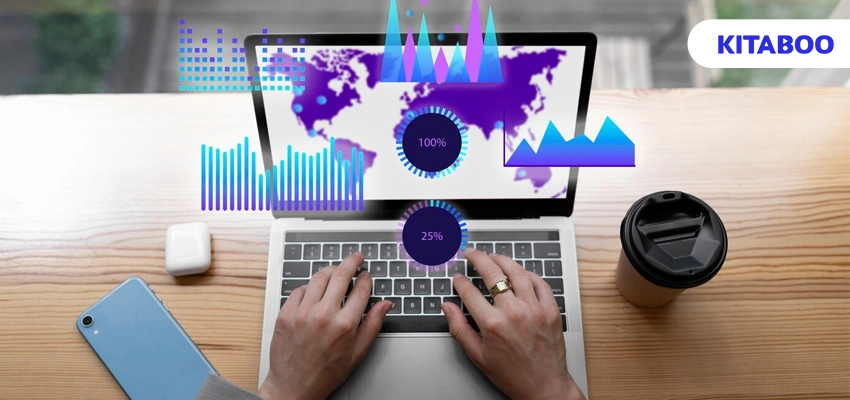
How to Use Analytics for Content Performance for Higher Education Students?
Summarize this blog with your favorite AI:
The digitalization of learning mediums and platforms in higher education has served as a catalyst for the rapid evolution of education refinement methods.The strategic use of analytics for content performance functions as a crucial way for educators and institutions to enhance the overall learning experience in a variety of aspects:
- Adjusting content for specific student requirements
- Recognizing students’ weak points and strengths
- Updating educational content to meet evolving standards
- Enhancing accessibility
- Providing dynamic feedback mechanisms
In this blog, we will explore in depth the ways in which analytics can be effectively employed to evaluate and elevate content performance for higher education students.
Table of Contents
Understanding Analytics for Content Performance
Analytics for content performance involves the systematic analysis of data generated by student interactions with the educational content provided. Leveraging insights for educational content enhancement empowers educators and administrators to make data-driven content decisions about tangible content attributes.
By optimizing the overall learning experience, educators are able to ensure that their educational content aligns simultaneously with the diverse needs of higher education students and regulated curriculum guidelines.
Customizing Content for Diverse Learning Styles
Analytics tools allow educators and administrators to gain a comprehensive view of how their students engage with content.
By identifying differences in learning styles, institutions can carefully analyze this data to refine their content delivery approaches. For instance, some students may learn better through video lectures, while others may grasp concepts more effectively through written or audio materials.
By personalizing learning content for individual student learning preferences, educators can significantly enhance student engagement, learning comprehension, and overall content effectiveness. This ability to adapt to various learning styles improves inclusivity in higher education, helping ensure that the educational content is able to resonate with a wider spectrum of students.
Digital textbook platforms like KITABOO allow educators and institutions to design tailored content for students, providing a structured framework for making adjustments and integrating diverse learning mediums.
Identifying Student Weaknesses
Analytics for content performance can help educators identify student learning patterns, and by tracking student interactions with content, educators can proactively identify those who may be facing challenges. Noticeable signs such as lower engagement, multiple failed attempts, or extended time for specific topics can be indicative of student struggles.
Thoughtful student assessment allows educators to provide productive support and strategies in order to help students improve their academic performance. This proactive approach safeguards students from falling behind and fosters a supportive learning environment.
Evaluating the Relevance of Educational Content
Meaningful formative assessments facilitated through analytics of content performance allow educators to determine the relevance of higher education materials. Understanding which topics are the most engaging and challenging for students helps with the refinement and updating of the curriculum.
This iterative process ensures that the content remains aligned with academic goals and stays responsive to the changing needs of students. Regular reviews and adaptive content ensure that higher education institutions can provide a dynamic learning experience and prepare students for real-world challenges.
Measuring Learning Outcomes
Analytics provide a way to quantitatively measure learning outcomes by meaningfully evaluating student performance.
Institutions can gauge the effectiveness of their content delivery through this data-driven approach. This allows educators to refine their teaching methods, adjust content, and ensure that students are able to reach their desired learning objectives.
The process of measuring learning outcomes aids in dealing with the arduous complexities of curriculum development while providing valuable insights into the efficacy of instructional methods so that institutions are able to enhance the quality of education continually.
Optimizing the Delivery of Content
Analytics tools can provide valuable insights into the logistics of how students access educational content. Recognizing peak engagement times allows educators to schedule announcements, assignments, and assessments strategically.
Analytics can also highlight preferred devices, helping optimize content for different platforms to ensure a more user-friendly experience. Emerging technologies that have paved the way for digital learning allow for the seamless integration of interactive elements, helping improve learning outcomes while providing a more accessible and inclusive learning medium for higher education.
Digital textbook platforms such as KITABOO allow educators to seamlessly integrate a diverse array of interactive elements into their educational content, fostering student engagement and adapting to different student learning styles.
Implementing Feedback Loops for Refinemen
Learning analytics allow for the implementation of dynamic feedback loops that drive continuous improvement. The regular analysis of content performance data enables institutions to implement iterative content changes to refine the learning experience.
This process ensures that educational content evolves alongside the advancements in current teaching approaches and emerging technologies, providing students with an up-to-date and robust learning experience.
Feedback mechanisms help address critical concerns and establish a culture of continuous improvement so that higher education institutions can maintain their agency and promptly respond to evolving needs and broader educational guidelines.
Conclusion
The strategic incorporation of analytics for content performance enables higher education institutions to provide a holistic, adaptive, and engaging learning experience, empowering educators to make data-driven decisions.
By customizing content, identifying at-risk students, and continuously evaluating and optimizing content delivery, institutions can unlock the full potential of analytics to elevate the academic success of their students.
Through this integration of analytics into content performance strategies, higher education institutions can ensure that students are equipped with the knowledge and skills necessary for success in today’s dynamic learning climate.
This is where digital textbook platforms like KITABOO come in, empowering higher education educators with the agency to utilize insightful data analytics, which in turn help content adapt to diverse student learning styles, facilitating student engagement to create a robust learning environment.
To know more, write to us at contact@kitaboo.com.
Discover how a mobile-first training platform can help your organization.
KITABOO is a cloud-based platform to create, deliver & track mobile-first interactive training content.


![Top 5 Free Publishing Sites for Independent Publishing [2026]](https://kitaboo.com/wp-content/uploads/2025/09/Top-5-Free-Publishing-Sites-for-Independent-Publishing-2026-420x235.webp)
